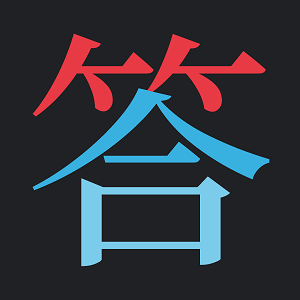答
부수: 竹
획수: 12획
答 has the meanings to answer and to reciprocate.

答 = 𥫗 + 合
X = semantic/phonetic borrowing + semantic/phonetic
• 𥫗 is a distortion of 艹 which depicts vegetation and is used to represent ‘beans’. Through a sound loan, it gets the meaning ‘to answer’ (the same meaning as 合).
• 合 depicts a mouth from above speaking downwards to a mouth below. This originally had the meaning ‘to answer’.
Evolution:
答 = a small bean ➔ borrowed use ➔ to answer ➔ to reciprocate
合 = 亼 + 口
• 亼 depicts a mouth speaking downwards from above.
• 口 depicts a mouth.
Mnemonic
See 合 as two mouths facing each other (one from the top-down and the other from the bottom-up). Imagine one mouth is asking a question and the other is answering.
Alternatively, understand that 合 can mean ‘join’ or ‘fit together’. Imagine a hut built together 合 from bamboo shoots with a thatched roof on top 𥫗.
Vocab
| 對하다 | 대하다 | to answer; to reply |
| 對答 | 대답 | answer; reply |
| 答辯 | 답변 | answer; reply |
| 答狀 | 답장 | written reply |
| 答信 | 답신 | reply; answer |
| 答辭 | 답사 | acceptance speech |
| 正答 | 정답 | correct answer |
| 誤答 | 오답 | incorrect answer |
| 問答 | 문답 | question and answer |
| 口答 | 구답 | verbal answer |
| 確答 | 확답 | definite answer |
| 應答 | 응답 | response; answer |
| 解答 | 해답 | answer; solution |
| 回答 | 회답 | formal reply |
| 答案紙 | 답안지 | answer sheet; answer paper |
| 報答 | 보답 | requital |
| 答禮品 | 답례품 | gift given in return |
Other resources
Image searches
Google
Bing
Yahoo Japan
Baidu (click 图片)
Sogou
Pinterest
Flickr
CJKV
CJKV Dict
Wikitionary
Unihan Database
Korean
Chinese
Written Chinese
Arch Chinese
ZDic
CC-Canto
Chinese Text Project
The Chinese University of Hong Kong (etymology)
Chinese Boost
Japanese
Takoboto
Jisho
JLearn.net
Sakura
The Kanji Map
Sentence Search
Immersion Kit
Vietnamese
Bibliography
— Daum 사전, [s.v. 答].
— Grant, B.K. (1982). A Guide To Korean Characters: Reading and Writing Hangul and Hanja, [s.v. 1153]. Seoul: Hollym.
— Outlier Dictionary of Chinese Characters, [s.v. 答, 𥫗, 合, 亼, 口].
— Seely, C., Henshall, K.G., & Fan, J. (2016). The Complete Guide to Japanese Kanji: Remembering and Understanding the 2,136 Standard Japanese Characters, [s.v. 202]. Singapore: Tuttle Publishing.